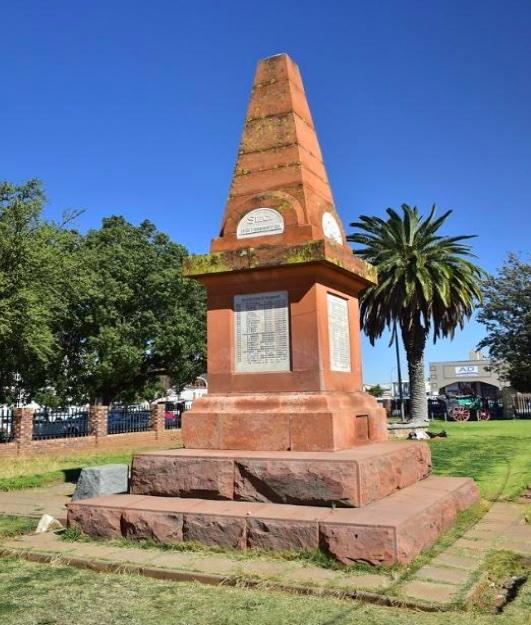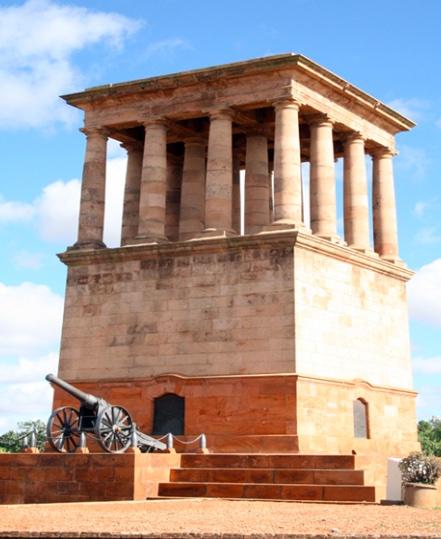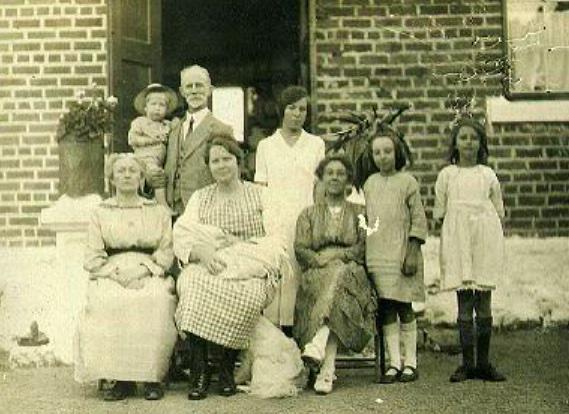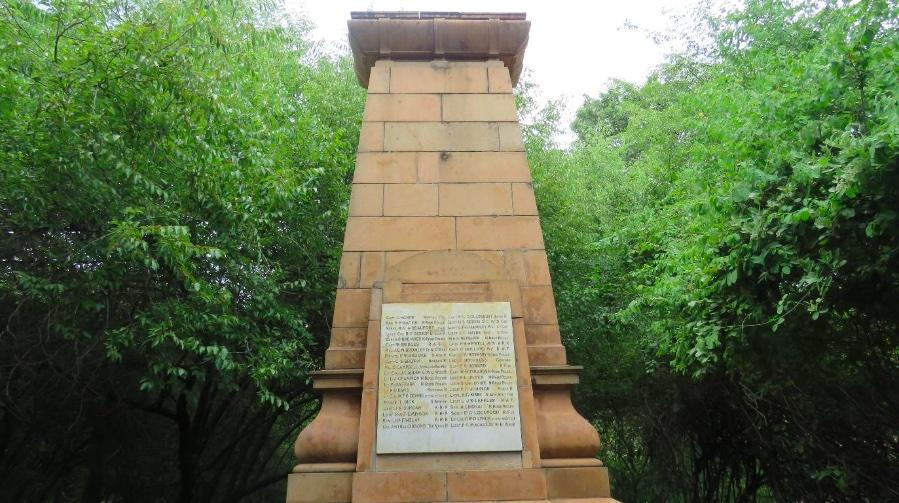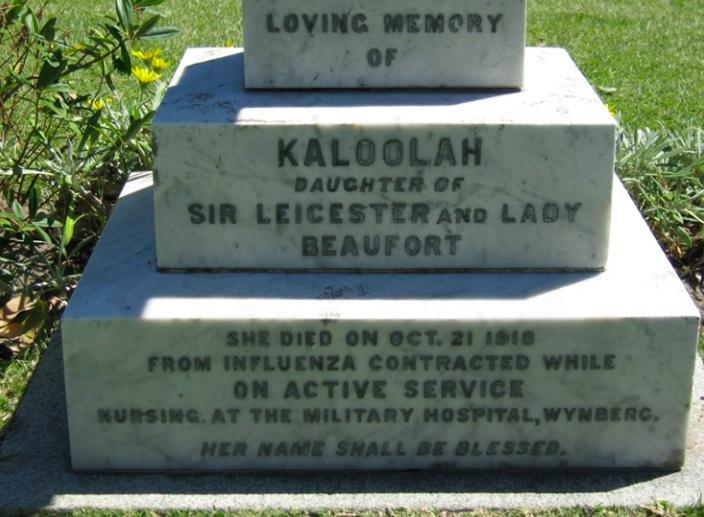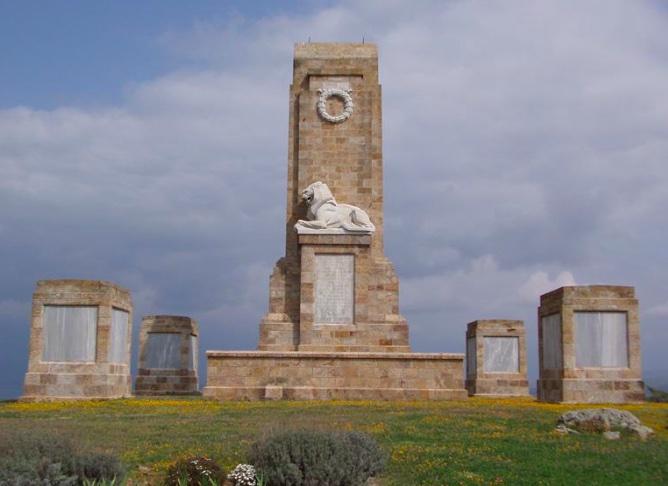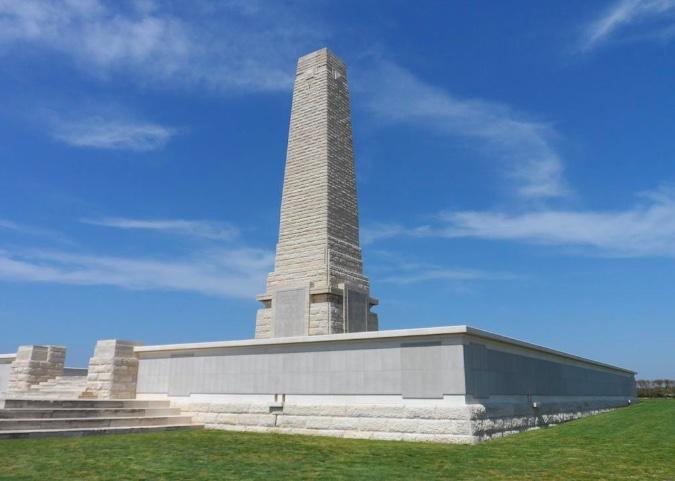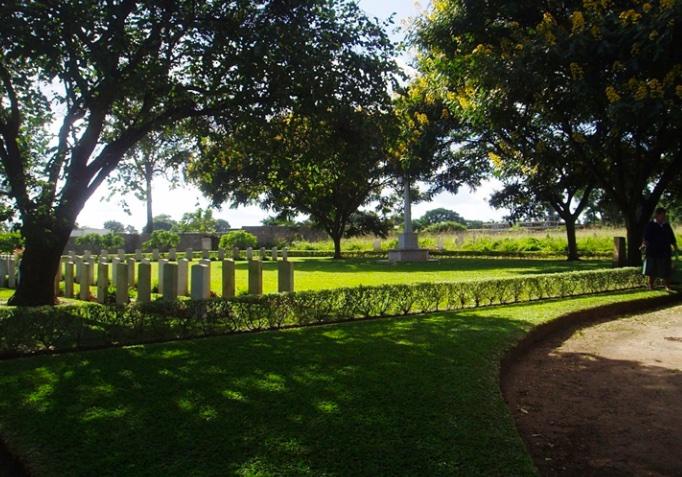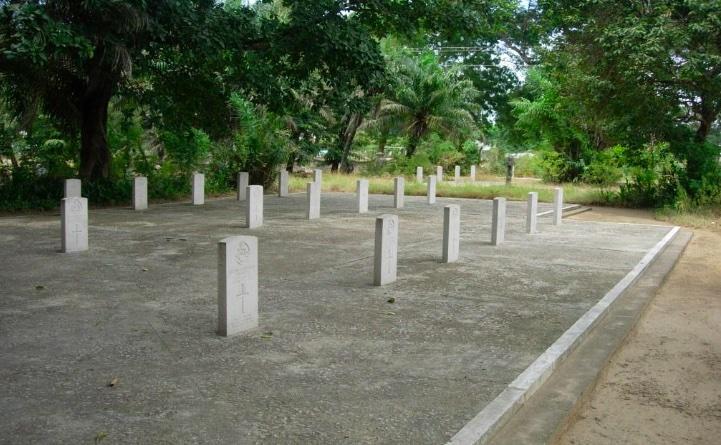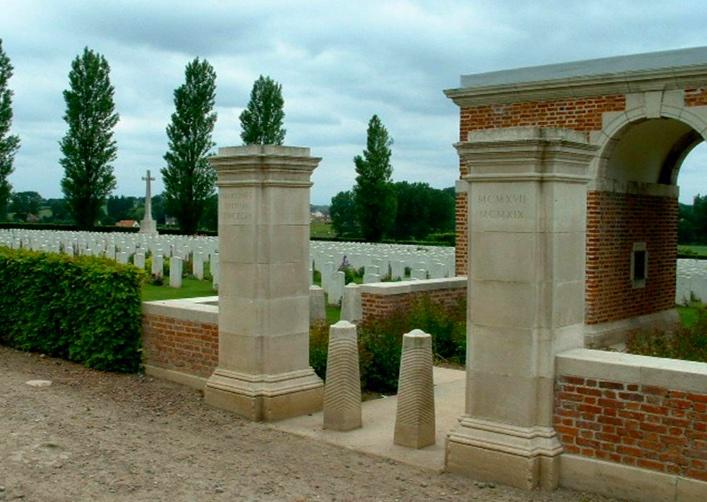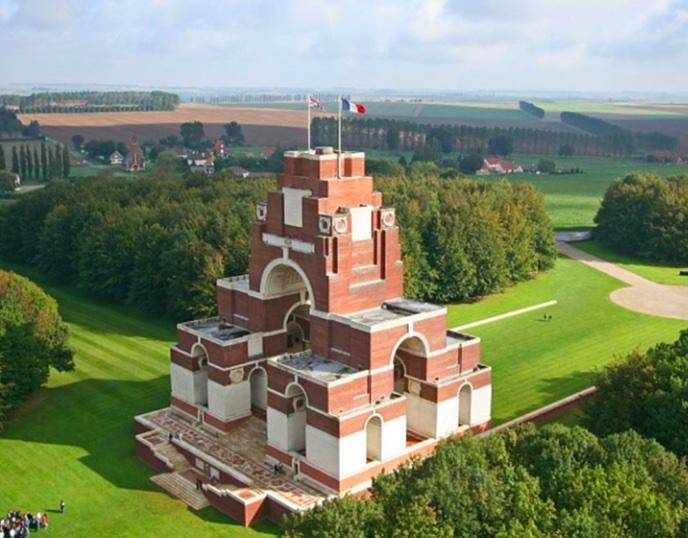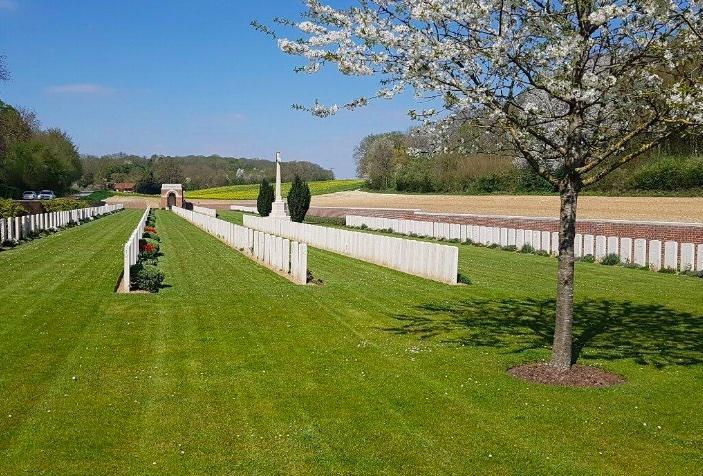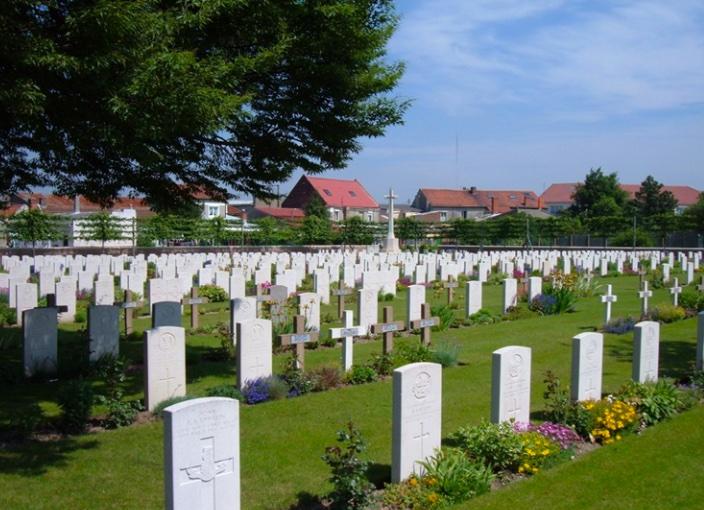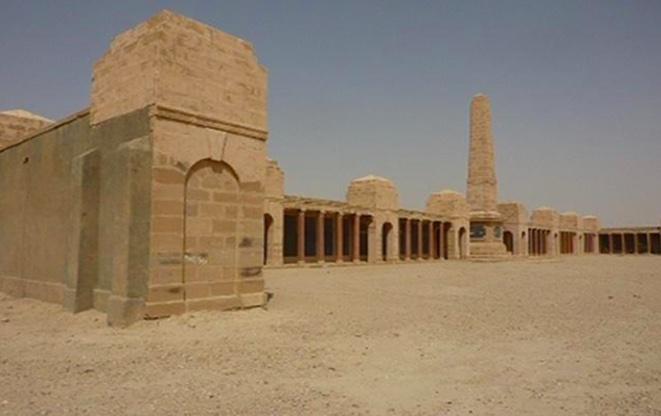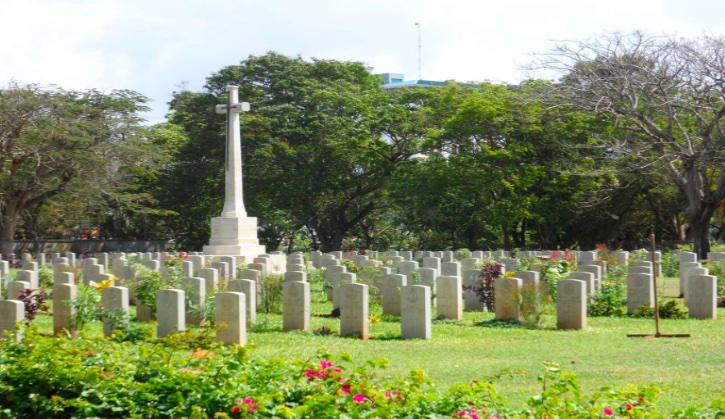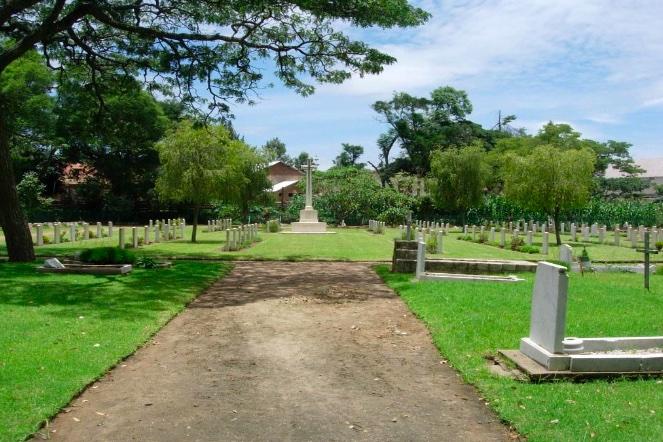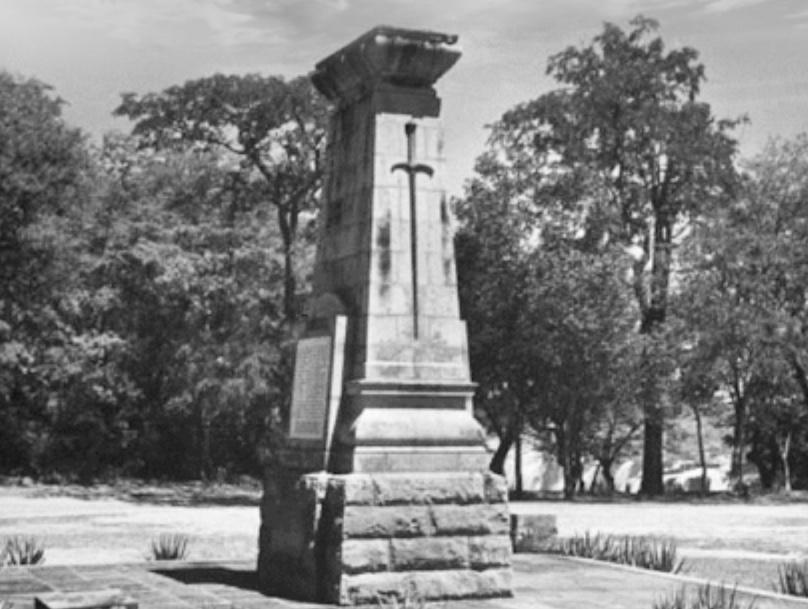
Disclaimer: Any views expressed by individuals and organisations are their own and do not in any way represent the views of The Heritage Portal. If you find any mistakes or historical inaccuracies, please contact the editor.
The ‘Northern Rhodesia Great War Memorial’ just inside the entrance to the Victoria Falls World Heritage Site, at Livingstone, Zambia, was erected in 1922 to ‘The Memory of Northern Rhodesians who gave their lives for the Empire in the Great War 1914 – 1918’.
The red sandstone slabs of this Memorial were quarried at the Pasipas Quarry, near the railway line to the north of Bulawayo.
According to Rob Burrett, a Zimbabwean archaeologist and historian, the Pasipas Quarry was one of two great quarries that provided building stone for the fine buildings of Bulawayo, during the period 1893 to 1920. This Quarry also served as an important supplier of sandstone gravestones during this period.
It furthermore supplied the sandstone slabs for the Honoured Dead Memorial at Kimberley and the old Siege Memorial in Mafikeng (now Mahikeng), and possibly other memorials and tombstones in South Africa, as well.
Siege Memorial at Mahikeng
Honoured Dead Memorial at Kimberley
The Bulawayo architectural partnership of Frank J Scott & James Roberston was responsible for designing the impressive Memorial. See the Artefacts website for their professional biographies.
The sandstone for the memorial was crafted by master stone mason and missionary, John Sheriff (1864 – 1935) who lived and served at the Forest Vale Mission, Bulawayo.
John Sherriff with family and friends, taken early 1920s. (find a grave.com)
Prince Arthur of Connaught, the then Governor General of The Union of South Africa, officially unveiled the War Memorial on 1 August 1923.
A recent view of the Cenotaph (SJ de Klerk)
The two inset marble tablets, detail the names and ranks of seventy-eight enlisted Europeans and their respective regiments and refer to the memory of ‘102 Askari whose names are recorded on the Northern Rhodesian Police Memorial at Livingstone’, as well as to ‘many other natives of the Territory of whose names no complete record exists’.
Those listed on the Memorial died whilst on military service in South Africa, East Africa, Zambia, Egypt, Europe, Asia Minor, and the Middle East.
Through the efforts of local resident Peter Jones, the services of Mark Davison, a stone mason from Ireland, was retained to renovate the Memorial. Following completion of the renovation, the Memorial was rededicated as a cenotaph on Sunday, 19 November 2017.
Because of the little recognition given to the Askari’s and War Porters, it is most appropriate that the Moto Moto Museum in Ndala curated during 2018 and 2019, an exhibition on the contribution of the ‘Askari’ Foot Soldiers and the ‘Tenga-Tenga’ War Carriers to the war effort in East Africa during the First World War. See Sources for more information.
Although Livingstone was distant from the war in East Africa, the headquarters of the Northern Rhodesian Police (NRP) was situated here. Recruits had to serve four years in the military branch of the NRP before they would qualify as Policemen. Therefore, all members of the NRP had military training, which proved useful upon the outbreak of war in 1914, when many were deployed on the northern border with hostile German East Africa, now Tanzania.
Two nearby information boards provide biographical details of the European servicemen and woman, listed on the Cenotaph, which are slightly elaborated upon below:
1) Captain Graham AGNEW 13th (Service) Battalion, the Northumberland Fusiliers, killed in action at Loos, 26 September 1915. He is commemorated on the Loos Memorial to the Missing.
2) Rifleman W 'Joe' BACON, Northern Rhodesian Police aged 37, was steward of the English Club at Elizabethville in the Belgian Congo when he made his way to Abercorn to assist the garrison of the Northern Rhodesia Police stationed there on the border with German East Africa, now Tanzania. On 17 March 1915, while encamping with a small contingent near the headwaters of the Samfu River, they were attacked by a superior enemy force. Although the enemy was repulsed, Rifleman Bacon and three Belgian Askari were killed. Bacon is buried or commemorated at the Ndola (Kansenshi) Cemetery, Zambia.
3) Nurse Monica Gertrude Alice BEAUFORT (Kaloolah), Volunteer Aid Detachment, was the daughter of Leicester Beaufort MA BCL, formerly Governor and Chief Justice of Labuan and British North Borneo, who was appointed as the first judge in North-Eastern Rhodesia in 1901. Her mother died at Fort Jameson and her father moved to Livingstone on the amalgamation of North-Eastern and North-Western Rhodesia in 1911. On 25 October 1915 Miss Beaufort and her stepmother left Livingstone by train for Cape Town. She joined the South African Military Nursing Service stationed at the Military Hospital, Wynberg, Cape Town where she died on 21 October 1918, from the Spanish Flu. Her grave is number BI UN 31 in Plumstead Cemetery, Cape Town. Her family called her Kaloolah, even on her gravestone.
Grave of Nurse ‘Kaloolah’ Beaufort. Plumstead Cemetery, Cape Town. (Peter H)
4) Lt Col Basil Frederic BISHOP MC, East Lancashire Regiment. Joined the North-Western Rhodesia Government Service on 11 August 1903 and served as an Assistant District Commissioner and Magistrate. Killed leading an attack while commanding the 9th South Lancashire, 22 Division on 18 Sep 1918 at Pip Ridge, Macedonia, on the Salonika Front, aged 39 years. He is commemorated on the Doiran Memorial, Greece.
Doiran Memorial, Greece, close to the border with Macedonia. The memorial was designed by Sir Robert Morimer with sculpture by Walter Gilbert. (CWGC)
5) Captain Alastair Bruce BREMNER joined the British South Africa Police as Trooper no. 870 in 1907 and commissioned as Sub-Inspector and Second Lieutenant in the Northern Rhodesia Police (NRP) early in 1911. Later that year he was posted to Mongu and operated against slavers on the Portuguese border. On the outbreak of war, he was a Lieutenant and sent ahead of the Mobile Column to recruit former Askari of the police and King’s African Rifles around Kasama to assist in the defence of the border with German East Africa. Bremner was promoted to Temporary Captain as a company commander on 2 April 1916 for the advance into German East Africa. He was on sick leave in the United Kingdom from 15 March until August 1917. On 9 October 1917 he resumed his temporary rank as Officer Commanding the NRP Depot at Livingstone. On 1 January 1918, while leading a draft to entrain for the front, he was thrown from his horse and died from injuries sustained. Buried at the Ndola (Kansenshi) Cemetery, Zambia
6) Captain Walter BRIDGES, 1034 Mechanical Transport Company, Army Service Corps died on 25 January 1919 in Italy. This company formed the Base MT Depot at Serravalle, Arquata, Italy. Interred at the Arquata Scrivia Communal Cemetery Extension, Italy.
7) Major John Edouard Marsdem BROMLEY DSO, Royal Field Artillery, was a Native Commissioner having joined the government service in 1908. He served with the 2nd Reserve Brigade Royal Field Artillery and later as Acting Major in command of a battery of XI Brigade RFA., 2nd Division, when killed in action on 7 June 1918, aged 36 years. Commemorated or buried at Anzin-St. Aubin British Cemetery, France.
8) Private Frank Washington BROOKE South African Rifles, initially served with the Rhodesia Nyasaland Field Force in East Africa from late 1915. Killed in action on 12 October 1916, aged 37 years, while serving with the 2nd South African Division on the Western Front. He has no known grave and is commemorated on the Thiepval Memorial to the Missing of the Somme.
9) Captain Colin Selwyn BROWN 11th (Lonsdale) (Service) Battalion, the Border Regiment, 97th Brigade, 32nd Division, was killed on 1 July 1916, one of some 20,000 officers and men killed on the first day of the Battle of the Somme, aged 26 years. Buried or commemorated at Lonsdale Cemetery, Authuille, France.
10) Volunteer George CAMPBELL Nyasaland Volunteer Reserve, Field Service Contingent enlisted on 2 March 1916 and died on 10 or 12 April 1916 at Karonga, Nyasaland now Malawi. Buried at the Karonga War Cemetery, Malawi.
11) Lieutenant Colonel John CARDEN CMG, Wiltshire Regiment, attested as Trooper no. 543 in the British South Africa Company's Police, newly raised for the occupation of Mashonaland on 13 July 1890. In 1892, Carden was appointed sub-inspector in the Umtali Municipal Police, which he left to become a scout for the Salisbury Horse and later a Remount Officer in the Matabele War of 1893. After service in the South Africa War, Carden was appointed Second in Command of the Barotse Native Police with the Local Rank of Lieutenant Colonel. He continued as Commandant of the Northern Rhodesia Police until 18 December 1912 when, having recently married he retired to the UK. On 30 September 1914 he became Second in Command of the newly raised 5th (Service) Battalion, the Wiltshire Regiment. Succeeding to the command, Lt Col John Carden led his battalion to Gallipoli where he was killed during the Turkish counterattack on Chunuk Bair on 10 August 1915, aged 45. He has no known grave, and is commemorated on the Helles Memorial, Gallipoli, Turkey.
The Helles Memorial is the main Commonwealth battle memorial for the whole Gallipoli campaign, and also commemorates the 20 956 Commonwealth servicemen with no known grave who died in this campaign in 1915–1916. (CWGC)
12) Lieutenant Maurice DAFFARN, Northern Rhodesia Police, was born in London. Educated at Winchester and Trinity College, Cambridge, He was commissioned into the 16th Lancers on 3 November 1909, but resigned his commission on 7 February 1912. He joined the Northern Rhodesia Government Service in September that year and was an Assistant Native Commissioner when attached to the Northern Rhodesia Police as a Temporary Second Lieutenant on 17 December 1914. On 24 April 1915, Daffarn and others attacked a German transport column near Mwazye, German East Africa. In the aftermath of this attack Daffarn, aged 27 years, was mortally wounded. He is buried at the Ndola (Kansenshi) Cemetery, Zambia.
Ndola (Kansenshi) Cemetery, Zambia. This cemetery contains 23 War dead concentrated from Abercorn European Cemetery and 2 concentrated from Livingstone Cemetery. It also contains a special memorial to 1 casualty known to be buried in Chikuula Military Grave and special memorials to 2 casualties formerly commemorated on the Ikawa (or Old Fife) Memorial, whose graves are not known. (CWGC)
13) Lieutenant Herbert Gough DAVIS, the Norfolk Regiment, was an Assistant Native Commissioner, but shortly before the war was severely mauled by a leopard. Sent to England to recuperate Davis obtained a captaincy in 3rd (Special Reserve) Battalion, the Norfolk Regiment only to die on 14 February 1915, aged 37. He is buried in the Dranouter Churchyard, Belgium.
14) Lieutenant Colonel Michael Frederick Beauchamp DENNIS DSO, Kings Own Scottish Borderers, was a farmer. In 1917 he became a Temporary Lieutenant Colonel in command of 7th/8th (Service) Battalion, the King's Own Scottish Borderers, 46th Infantry Brigade, 15th (Scottish) Division. Dennis was killed on 19 May 1918, aged 37. Buried at Ecoivres Military Cemetery, Mont-St. Eloi, France.
15) Private Thomas DICKENS, 1st South African Infantry was the husband of Caroline Dickens, of Broad Road, Wynberg, Cape Province. He was killed in action on 18 October 1918, and buried at Naves Communal Cemetery Extension, France.
16) Rifleman James Kirk DUNCAN, King’s Royal Rifles (KRR), of Kawambwa, Zambia, born at Paisley, enlisted in the Training Reserve at Hamilton. He subsequently served with 2 KRR Corps when killed on 9 July 1917. Buried or commemorated at the Nieuport Memorial, Belgium.
17) Second Lieutenant Robert Astley Franklin EMINSON BA, King’s Royal Rifles, Downing College Cambridge, was an Assistant Entomologist with the British South African Company. Commissioned into 6th (Special Reserve) Battalion KRRC and serving as a Lieutenant with the Machine Gun Corps, when killed in France on 20 July 1916, aged 24 years. Buried or commemorated at the Becourt Military Cemetery, Becordel-Becourt, France.
18) Rifleman James Reid FINDLAY, King’s Royal Rifles, from Blairhead was serving with 2nd KRR Corps when he died on 30 June 1916. He is commemorated on the Arras Memorial to the Missing.
19) Colonel Alfred St Hill GIBBONS, the King’s Regiment, first reached the Victoria Falls in 1895 and hunted and explored in Barotseland until March 1896. In 1898, he returned to the UK. In 1904, his book, 'Africa from South to North Through Marotseland was published in London by John Lane. Lt Col Gibbons was on the Somme in command of 13th (Service) Battalion, the King's (Liverpool Regiment), 9th Infantry Brigade, 3rd Division when he was wounded on 14 July 1916, and died the following day, aged 53 years old. Buried at the Daours Communal Cemetery, France.
Tanga European War Cemetery, Tanzania containing 29 Commonwealth burials of the First World War. (CWGC)
20) Captain Henry Cullen GOULDSBURY, Berkshire Regiment, was Native Commissioner at Mporokoso. Departed Northern Rhodesia on 31 December 1914 to obtain a commission in 9th (Reserve) Battalion, the Royal Berkshire Regiment. Captain Gouldsbury was serving with 2nd/1st King's African Rifles when he died on 27 August 1916, aged 35 years. Buried Tanga European Cemetery, Tanzania.
21) Second Lieutenant Harold Stewart GREEN DCM, 4th Dragoon Guards, an Assistant Native Commissioner enlisted in the 4th (Royal Irish) Dragoon Guards. For his work carrying messages under fire and crawling close to the enemy lines to listen for underground tunnelling, and locating an advanced line of enemy posts, acting Corporal Green was awarded the Distinguished Conduct Medal and was commissioned. Green was killed on 4 April 1918 and commemorated or buried at Ribemont Communal Cemetery Extension, Somme, France.
22) Lieutenant Guy Frederick Beckham HANDLEY MC, Coldstream Guards, joined the North-Western Rhodesia Administration in 1906 and was a Native Commissioner when he left to join 8th (Service) Battalion, the King's Own Yorkshire Light Infantry, 70th Infantry Brigade, 23rd Division. He was an Acting Captain with 2nd Battalion Coldstream Guards when killed on 27 August 1918, aged 35 years. Buried at Mory Street, Military Cemetery, St. Leger, France.
23) Lieutenant John Carolin 'Jack' HAYES MC, Coldstream Guards, of the Survey Department joined the Mobile Column of the Northern Rhodesia Rifles. He served as a rifleman on the northern border until his unit was disbanded in early 1916. Having served as a Second Lieutenant with 2nd Battalion, Coldstream Guards, Lieutenant Hayes was admitted to hospital at Le Havre where he died of the Spanish Flu on 19 November 1918, aged 35 years. Interred at Ste. Marie Cemetery, Le Havre, France.
24) Rifleman George HEPBURN, Northern Rhodesia Rifles, was a rubber and ivory trader in civil life. He remained at the Front as a scout with the Southern Rhodesia Column when the Northern Rhodesia Rifles were stood down. He died of dysentery at Fife (now Nakonde) on the border with German East Africa (Tanzania), on 3 April 1916, aged 46 years old. Buried at Ndola (Kansenshi) cemetery, Zambia.
25) Lance Corporal Henry Havelock HIPWELL MM, King’s Royal Rifle Corps, of Umvuma and Broken Hill, served in the 2nd Rhodesia Regiment in East Africa. Hipwell was deemed fit for service in Europe, after recuperative leave, and left Southern Rhodesia on 4 September. RR1565 Lance Corporal Hipwell was a member of 1st South African Infantry when reported wounded and missing on 29 October 1918. He is commemorated on the Vis-en-Artois memorial.
26) Captain Charles HOLLAND MC, Royal Flying Corps, was one of the 25 men who marched from Fort Jameson to join the Northern Rhodesia Rifles at the Front. He served as a Captain in 8 Squadron, Royal Flying Corps, when he was killed on 25 January 1918, aged 31 years. Interred at Horsham (Hills) Cemetery, UK.
27) Captain Charles Cooper HORNSBY, Northern Rhodesia Police. 1051 Trooper Hornsby joined the BSAP in 1909 and commissioned into the Barotse Native Police on 16 August 1911. He later served in German East Africa as a Temporary Captain commanding 'F' Company NRP but admitted to hospital at Lupembe (Tanzania) in March 1917, where he died of enteric fever on 12 May, aged 31. Buried at the Iringa Cemetery, Tanzania.
Wancourt British Cemetery containing the remains of 1112 casualties, near Arras, designed by Sir Edwin Lutyens. (CWGC)
28) Lieutenant Gilbert HOTCHKISS, The Gordon Highlanders, left his brother's farm at Kafue and trekked with the Northern Rhodesia Rifles to the Northern Border. He departed to England to join the Inns of Court Officer Training Corps, as Pte No.4/3/4462 on 28 June 1915. Hotchkiss was commissioned into the Gordon Highlanders on 1 January 1916 and killed in action on 23 April 1917, aged 23. Buried in Wancourt British Cemetery.
29) Captain Francis Stanley HOWARD, Royal Fusiliers, an Assistant Native Commissioner was commissioned into the London Regt 3rd Bn Royal Fusiliers. Killed on 28 November 1915, aged 36 years at Loos on the Western Front. He is commemorated on the Loos Memorial.
30) Captain William T HUSBANDS, Northern Rhodesia Police (NRP), went to war as a Corporal with the BSAP. He was an acting Warrant Officer by 1 February 1916, when granted a temporary commission in the NRP while Officer in Charge of Supplies, Northern Border, at the Kasama Base Depot. He died as a temporary Captain at Kasama, Zambia on 24 December 1918, aged 31 years.
31) Lieutenant Ernest Lucien INGPEN, Northern Rhodesia Police, joined the BSAP as Trooper No. 1611 in 1912, and commissioned as a Special Service Officer with the NRP on 6 October 1914. On 7 June 1916, Ingpen accompanied a few others to the gate of the German Fort at Bismarcksburg under the mistaken belief that the garrison had surrendered. They were met by the Commandant, Lieutenant Hasslacher, who corrected them. Seizing the German officer, the party withdrew under fire from three sides. Mortally wounded in the groin, Ingpen cleared the abattis in one desperate leap. He is buried in the Ndola (Kansenshi) Cemetery, Zambia.
32) Lieutenant Charles Edward Stannus IRVINE, Northern Rhodesia Rifles, studied engineering at Trinity College Dublin and after serving in the South African War joined Rhodesia Railways. In December 1914, he was commissioned to command the Left Section of the Northern Rhodesia Rifles in the Field. On 16 April 1915, forty men of the Rifles and twenty of the NRP marched for five and a half hours from Fife to surprise the enemy post at Mwanangombe, Zambia. Irvine was first into the stockade but fell mortally wounded. Interred at Ndola (Kansenshi) Cemetery, Zambia.
33) Second Lieutenant Percy Clarkson JOHNSON, 1/8th Battalion, the Manchester Regiment, 42nd (East Lancashire) Division, was killed at Helles, Gallipoli, on 16 May 1915, aged 40 years. Commemorated on the Helles Memorial, Turkey.
34) Lance Corporal Harold Gordon KIRBY B Coy 4th Regt, South African Infantry. Son of Edward Williams Kirby and Emma Kirby, of Rowlandia Farm, Lusaka, Northern Rhodesia. Born in Colorado, USA, he joined the SA Mounted Police in Cape Town. Attested to the Transvaal Scottish and went to Europe as part of the SA Expeditionary Force. Killed in action at Delville Wood on 19 July 1916, aged 26. He is commemorated on the Thiepval Memorial to the Missing.
Thiepval Memorial to the Missing of the Somme commemorating the 72 337 casualties who have no known grave. Designed by Sir Edwin Lutyens. (Roath Local History Society)
35) Lieutenant John Wilfred LEFFLER Royal Air Force, born 5 April 1892, killed in training on 25 Sep 1918, and buried in Brighton.
36) Rifleman Alexander LINDSAY, Northern Rhodesia Rifles, had left his farm west of Chilanga to join the Northern Rhodesia Rifles. On 6 May 1915, fifty men of the Rifles encountered an enemy patrol near Mukoma's Village and captured an Askari's kit. The Rifles bivouacked on the Missipissi Stream, where they were fired on by a German contingent. The men rallied to their alarm posts and drove off their attackers for the loss of Riflemen Lindsay and Warren and five African carriers killed. Lindsay and Warren are both interred at the Ndola (Kansenshi) cemetery, Zambia.
37) Sergeant Edgar Gilbert LOCKWOOD 25th (Frontiersmen) Battalion, the Royal Fusiliers was born in Wakefield. He died on 16 December 1917, aged 39 years, and interred at the Dar es Salaam War Cemetery.
38) Lieutenant Colonel Colmer William Donald LYNCH DSO, the King's Own Yorkshire Light Infantry, Reserve of Officers, joined 9th (Service) Battalion in 1914. He was Temporary Lieutenant Colonel, commanding the battalion in the 64th Brigade 21st Division, from disembarkation in France in August 1915, until killed on the Somme on 1 July 1916, aged 35 years. Interred at Norfolk Cemetery, Becordel-Becourt, France.
Norfolk Cemetery Becordel-Becourt France, containing the remains of 326 casualties (CWGC)
39) Sergeant Frederic Charles MACAULAY, King Edward’s Horse, accompanied Colin Harding when he first entered Barotseland in October 1899, and trained the first African recruits for the Barotse Native Police. Macaulay served with the Matabeleland Mounted Police in the Rebellion of 1896. As a Corporal, he was second in command of Robert Coryndon's British South Africa Police escort when the latter assumed his appointment as the Resident Commissioner in Barotseland in September 1897. On 7 September 1901, Macauly was appointed a Sub-inspector in the Barotse Native Police and in 1902 was in command at Kasempa from where he led patrols against slavers' caravans. Macaulay left Northern Rhodesia on 28 October 1914. No.729 Sergeant F C Macaulay served with 'C' Squadron, 1st King Edward's Horse, 47th (2nd London) Division. On New Year's Day 1916 Macaulay went into the Line at Loos in command of eight sharpshooters from the squadron. On 14 January 1916, the sharpshooters reported that Macaulay, aged 41 years, had been killed by shell fire. He was the youngest of three brothers, all of whom were killed in action. His remains are interred at Maroc British Cemetery, Grenay, France.
Maroc British Cemetery, Grenay, France, containing the remains of 1126 casualties (CWGC)
40) Lieutenant Humphrey Gilbert MACHELL, of the 3rd Battalion attached 8th (Service) Battalion, the Border Regiment, 75th Brigade, 25th Division, died on 12 June 1918, in France, aged 30 years. Interred or commemorated at St. Sever Cemetery, Rouen, France.
41) Dr Dundas S MacKNIGHT, Royal Navy, was in practice at Broken Hill (now Kabwe) in 1909. He died on 9 November 1918 as a Surgeon Lieutenant of the Royal Navy, aged 43, and is buried at North Front Cemetery, Gibraltar. MacKnight was serving on board HMS Brittania, which was torpedoed by a German U Boat in the western approaches to the Straits of Gibraltar.
42) Rifleman D S 'Archie' MacGREGOR, 2nd Rhodesia Regiment, but originally Northern Rhodesia Rifles until their disbandment. He served as an Intelligence Agent in East Africa, until killed on 25 November 1917.
43) Rifleman George McKNIGHT, South African Infantry – originally Northern Rhodesian Rifles no. 74, then 2nd Rhodesia Regiment. Died 18 April 1918 and interred at Cambrin Military Cemetery, France.
44) Second Lieutenant Donald Cameron McMILLAN, King’s Royal Rifle Corps was serving with 12th KRR Corps, 60th Brigade, 20th (Light) Division when he died of wounds on 11 March 1916, aged 29 years. Buried at Calais Southern Cemetery, France.
45) Rifleman Jacob MERBER aka RABINOWITZ King’s Royal Rifle Corps managed the Susman Brothers' Store at Sesheke until his marriage in 1909. No. R36830 Rifleman Merber served with 2 KRR Corps in France where he died of wounds on 10 July 1917. Commemorated on the Nieuport Memorial, Belgium.
46) Volunteer John MINSHALL, joined the Nyasaland Volunteer Reserve on 14 August 1917, died 5 May 1918, and buried at Mangochi Town Cemetery, Malawi.
47) Corporal Herbert Walter NISBETT, Gordon Highlanders, died 25 December 1917. No details available on the Commonwealth War Grave Commission’s website.
48) Captain Hugh Frederic North, 1st 4th Battalion, the Hampshire Regiment, was a government servant possibly in the Survey Department. He was killed on 12 January 1916, aged 28 years, in Mesopotamia. Commemorated on the Basra Memorial to the Missing, Iraq.
Basra Memorial to the Missing, designed by Edward Prioleau Warren (CWGC)
49) Private Ernest William OSBORNE, Rhodesia Regiment, left Livingstone to join 2nd Rhodesia Regiment, but was killed in France with the 1st South African Infantry on 10 April 1918, aged 30 years. Commemorated on the Ypres (Menin) Gate Memorial to the Missing of Belgium Flanders.
50) Lieutenant Geoffrey PALMER RE, 153 Field Company Royal Engineers 37th Division, was killed in action on 19 November 1915, in France, aged 34 years. Commemorate or buried at the Foncquevillers Military Cemetery, France.
51) Rifleman Kenneth Douglas PEACOCK Rhodesia Regiment was a government clerk in North-Western Rhodesia from 1903 until October 1911. He served on the Northern Border as Rifleman No. 10 in the Northern Rhodesia Rifles and then joined 2nd Rhodesia Regiment as No.1575, dying at Morogoro, Tanzania, on 18 January 1917, aged 33 years. Commemorated or buried at the Morogoro Cemetery, Tanzania.
52) Captain Henry Goold PEARCE MC, Royal Engineers, was manager of Champion Mine at Umtali when he left to become manager of the King Edward Mine in Northern Rhodesia. He served at the front in the ranks of the Northern Rhodesia Rifles before leaving for England to join the Royal Engineers. Pearce was serving with 171 Tunnelling Company, when killed in action on 15 July 1917, aged 31 years. Buried or commemorated at Poperinghe New military Cemetery, Belgium.
53) Lieutenant Herbert Stanley PLANT, Royal Engineers, of 181 Tunnelling Company attached to 52nd Infantry Brigade 17th Division died on 18 February 1918, in France. Buried or interred at Bucquoy Road Cemetery, Ficheux, France.
54) Captain John Matthew POUND, Royal Marines Light Infantry, was an Assistant Native Commissioner. He was killed on the Somme on 13 November 1916, aged 34 years. Commemorated on the Thiepval Memorial to the Missing of the Somme.
55) Rifleman Drostan Arthur Cummin RUSSELL, Northern Rhodesia Rifles, was educated at Radley and Balliol, Oxford. He worked as a surveyor for the Canadian Northern Railway in British Columbia before becoming Private Secretary to Aubrey Wallace, Administrator of Northern Rhodesia, who released him to join the Northern Rhodesia Rifles. Russell died of blackwater fever at Serenje, Zambia, on 25 July 1915. Commemorated on the Ndola (Kansenshi) Cemetery Special Memorial.
56) Captain Thomas Leopold RUSSELL, King’s African Rifles, died as an Acting Captain in 3/2KAR on 6 November 1917, aged 38. Buried or commemorated at the Dar es Salaam War Cemetery, Tanzania.
Dar es Salaam War Cemetery, Tanzania, containing the remains of 1844 casualties(CWGC)
57) Major Martin RYAN MC 25th Battalion Royal Fusiliers died in East Africa on 18 October 1917, aged 40 years. Interred in the Dar es Salaam War Cemetery.
58) Captain Frederick Gordon de SATGE, King’s Royal Rifle Corps, became a Midshipman in 1898. He served in China during the Boxer Rebellion of 1900 but resigned his commission as a Sub-lieutenant in 1903. de Satge then served as a Trooper in the Cape Mounted Riflemen, the Cape Police and finally the BSAP until June 1909, when he was commissioned in the Barotse Native Police. He went to German South-West Africa with 1st Rhodesia Regiment and on 11 June 1915 was commissioned as a Lieutenant in 6th (Special Reserve) Battalion, The King's Royal Rifle Corps, being attached to the 4th Battalion at the Front by September. Apparently granted a regular commission in the 1st Battalion, he was attached to 7th (Service) Battalion KRRC, 41st Brigade, 14th (Light) Division from 16 July 1916. During September 1916, the Battalion occupied Delville Wood, where on 17 September, de Satge was originally reported as missing believed wounded, but later confirmed as one of 3 officers of his Battalion killed together with 21 other ranks. He is commemorated on the Thiepval Memorial to the Missing of the Somme.
59) Private Cecil Herbert Sauerman, 2nd South African Infantry. Died of his wounds on 17 January 1918, aged 23 years. He is interred in the St. Sever Cemetery Extension, Rouen, France.
60) Sergeant Thomas Robert Landy SAVORY, 2nd Rhodesia Regiment, died at Salisbury (now Harare), on 1 October 1917, aged 23 years. Interred in the Harare Pioneer Cemetery, Zimbabwe.
61) Company Sergeant Major Charles William SELL DCM, Northern Rhodesia Police, served as a trooper in the Bulawayo Field Force during the Matabele Rebellion of 1896. He was an elephant hunter in Northern Rhodesia and volunteered as a scout for the NRP in 1914. On one occasion, with a small party of Scouts, he held up and inflicted many casualties on an enemy advanced guard, himself bringing a wounded man out of the action. Sell died of wounds on 29 May 1918, aged 41 years. Interred in the Mangochi Town Cemetery, Malawi.
62) Scout Norman SINCLAIR, Northern Rhodesia Police, a scout was on reconnaissance in Angola, when armed only with a Bowie knife encountered a lion, on 9 May 1915. Both Sinclair, and the lion died in this encounter. Sinclair is buried or commemorated at the Dar es Salaam War cemetery.
63) Second Lieutenant Charles Millington SING, Royal Sussex Regiment, had been an Assistant Native Commissioner since 1911. He was commissioned in the Royal Sussex Regiment and joined its 7th (Service) Battalion, 12th (Eastern) Division, in France on 19 March 1916. He died of wounds on 7 July 1916, aged 27. Interred in the Serre Road Cemetery, No. 2, France.
64) Volunteer Herbert H SMITH, Nyasaland Volunteer Reserve, joined the Field Service Contingent on 21 June 1916 and died at Neu Langenberg (now Tukuyu in southern Tanzania) of enteric and malaria on 5 April 1917. Buried at the Iringa Cemetery, Tanzania.
Iringa Cemetery, Tanzania contains 131 Commonwealth graves from the First World War. The CWGC also cares for 16 German war burials within this cemetery. (CWGC)
65) Sergeant A J SMITH, - regiment is not given on the memorial, possibly because of the confusion over units he served with 7th Bn the London Regiment and 1st 4th KAR. Information not available on the CWGC website.
66) Major Alfred SOAMES DSO, 6th (Service) Battalion the Royal East Kent Regiment (The Buffs) 37th Brigade, 12th (Eastern) Division, born 16 September 1862, served in the South African War in 1901. He received the Queen's Medal with a clasp and was created a Companion of the Distinguished Service Order. Killed in action near Hulloch in France on 13 October 1915, aged 53 years. He is commemorated on the Loos Memorial to the 20 637 officers and men who have no grave, who fell in the area from the Battle of Loos to the end of the war.
67) Rifleman William STEVENS, Northern Rhodesia Rifles, was killed when taking over piquet duty at Tunduma near Fife on 11 November 1915, aged 47 years. Interred or commemorated at the Ndola (Kansenshi) Cemetery, Zambia.
68) Second Lieutenant Henry Joseph Ignatius Maxwell-STUART, Coldstream Guards, was another member of the Survey Department who joined the Northern Rhodesia Rifles. He was later commissioned in 3rd Battalion Coldstream Guards and killed in action on 9 October 1917, aged 30 years. He is interred at Artillery Wood Cemetery, Belgium.
69) Lieutenant Henry William TARBUTT, Northern Rhodesia Police, joined the BSAP as Trooper No. 1521 in 1911 and was a Sergeant with the Southern Rhodesia Column when commissioned into the NRP on 5 April 1917. On 9 August 'A' Company NRP drove in two enemy pickets before assaulting an enemy position at Tuturu. Leading the charge, Tarbutt, aged 26 years, was bayoneted in the throat, and fell into the German trench. Four African Policemen died with him. Before retiring the Germans buried Tarbutt in a grave marked 'Lt Tarbutt, A Coy N.R. Police. In honour of a brave man'. His remains were later reinterred in the Iringa Cemetery, Tanzania.
70) Private Joseph Collins TAYLOR, 2nd Rhodesia Regiment, died on 11 July 1916 aged 32 and buried at the Dar es Salaam War Cemetery.
71) Private R J F URQUHART, 2nd Rhodesia Regiment from Broken Hill, later joining 1st South African Infantry. He died as a prisoner of war in Germany on 18 October 1918. Buried or commemorated at the ORS British Cemetery, France.
72) Rifleman Arthur John 'Mad Jack' or 'Matabele' WARREN, Northern Rhodesia Rifles, a Lusaka builder, and farmer, was killed together with Alex Lindsay on 17 May 1915.
73) Captain Geoffrey Fell WATHERSTON, East African Forces, was Orderly Room Sergeant of the Barotse Native Police by 1 October 1903 and commissioned as Sub-Inspector on 1 October 1904. He was in command at Kaunga from December until March 1905. From 1 February 1908 until 31 March 1909, he was seconded as Commandant of the North-Eastern Rhodesia Constabulary with the local rank of Captain. At the commencement of war, he joined the East African Forces and soon promoted to Sergeant in a machine gun company. He subsequently regained his old rank with the Uganda Police Service Battalion before he died on 27 November 1916, and buried in Jinja War Cemetery, Uganda.
74) Lance Corporal William Wallace WAUGH, Royal Buckinghamshire Hussars, was born at Maybole, but enlisted at the Cape. He died in Egypt on 12 August 1916, aged 31 years and buried at the Cairo War Memorial Cemetery, Egypt.
75) Lieutenant Edward Gordon WILLIAMS, Special Reserve, 2nd Grenadier Guards was killed in France on 12 August 1915, possibly accidently, aged 27 years. Buried at the St Venant Communal Cemetery, France.
76) Sergeant Joseph WILSON, 3rd King’s Royal Rifle Corps, was born at Belfast. He enlisted in Southern Rhodesia and was killed on the Western Front on 8 May 1915. He is commemorated on the Ypres (Menin) Gate to the Missing of the Somme, Belgium.
77) Rifleman David Alexander WOOD, Northern Rhodesia Rifles, was in Katanga at the outbreak of war and served as a volunteer with the Belgian forces before joining the Northern Rhodesia Rifles. On 28 June 1915, a German force surrounded Saisi in the early morning mist and bombarded the garrison with a field gun. No.121 Rifleman Wood and another rifleman were sent with a section of NRP to reinforce the piquet at the Saisi bridge, where Wood was killed, aged 42 years. Interred in the Ndola (Kansenshi) Cemetery, Tanzania.
78) Rifleman John BEATTIE, Northern Rhodesia Rifles. Died at Lubwa Mission, Northern Rhodesia on 26 June 1916 aged 37 years. Buried Chinsali, Zambia. His name appears on the South African panel on the Hawick Roll of Honour. No information on the CWBC website.
Main image: A contemporary image of the Cenotaph at Victoria Falls, Livingstone, Zambia
SJ de Klerk is a retired human resources practitioner. Since retirement he has been writing articles on various aspects of South African history for The Heritage Portal. He is Chair of the Northern Branch of the Archaeological Society.
Sources
- Artefacts website on South African architects - https://www.artefacts.co.za
- Burrett R. & Mateke C. Shongwe- The Rich Heritage of Livingstone and Victoria Falls. Khami Press, Bulawayo. 2018.
- Commonwealth War Graves Commission – https://www.cwgc.org
- The First World War in Northern Rhodesia: Experiences of ‘Askari’ Foot Soldiers and the ‘Tenga-Tenga’ War Carriers. Exhibition at the Moto Moto Museum in Ndala, 20 November 2018 to 31 March 2019.
Comments will load below. If for any reason none appear click here for some troubleshooting tips. If you would like to post a comment and need instructions click here.

